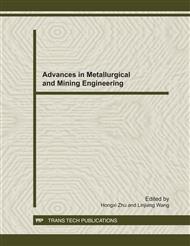[1]
Navarro P, Simpson J, Algucil F J. Hydrometallurgy, 53(1999),pp.121-131
Google Scholar
[2]
Xuewen Wang, Qiyuan Chen, Zhoulan Yin, Mingyu Wang, Bingrui Xiao, Fan Zhang. Hydrometallurgy, 105(2011),pp.355-358
Google Scholar
[3]
P. Navarro , F.J. Alguacil. Hydrometallurgy, 66(2002),pp.101-105
Google Scholar
[4]
T. Shibata, M. Hashiuchi, T. Kato. In: J. E. Hoffmann, R. G. Bautista, V. A. Ettel, et a1. eds. The Electrorefining and Winning of Copper. Warrendal: Metal. Society Inc(1987).pp.99-116
Google Scholar
[5]
Hyvarinen, O.V.J.,U S Patent: 4,157,946.(1979)
Google Scholar
[6]
Cunnigham, R.M., Calara, J.V., King, M.G., 1997. In: Mishra, B. (Ed.), EPD Congress. TMS, Warrendale, PA, USA, pp. pp.453-460
Google Scholar
[7]
Fa-xin XIAO. Novel technology of purification of copper electrolyte and basic research. Central South University(2008).(in Chinese)
Google Scholar
[8]
XIAO Fa-xin, ZHENG Ya-jie, WANG Yong, XU Wei, LI Chun-hua, JIAN Hong-sheng. Trans. Nonferrous Met. SOC. China 17(2007) ,pp.1069-1074
Google Scholar
[9]
Bing-rui XIAO, Zhong-fu SU, Yi-huang LI, Zi-ping LONG, Ming-jin HUANG. CN 02,129,694.4. (2003). (in Chinese)
Google Scholar
[10]
Hong-quan HUA, Yu ZHANG. Mining and Metallurgy,20(2011) ,pp.68-71. (in Chinese)
Google Scholar
[11]
Wang Xuewen, Long Ziping , Su Zhongfu, et a1, in: Adsorption of impurities in copper electrolyte onto silver extracted residue of copper anode slime, edited by X. W. Yang. A. P. He, Q. Y. Chen eds. Proceedings of the third international conference on hydrometallurgy. Beijing: International Academic Press(1998).pp.660-662
Google Scholar
[12]
WANG Xue-wen, CHEN Qi-yuan, YIN Zhou-lan, XIAO Lian-sheng. Hydrometallurgy, 84(2006),pp.211-217
DOI: 10.1016/j.hydromet.2006.05.013
Google Scholar
[13]
T. Nishimura and K. Tozawa. Metall. Rev, MMIJ,3(l986),pp.131-145
Google Scholar
[14]
WANG Xue-wen, CHEN Qi-yuan, YIN Zhou-lan, ZHANG Ping-min, LONG Zi-ping, SU Zhong-fu. Hydrometallurgy,69(2003),pp.39-44
Google Scholar
[15]
E. R. Losilla, M. A. Salvado´, M. A. G. Aranda et a1. J. Mol. Struct.,470(1998),P. 93-104
Google Scholar
[16]
H. Naïli & T. Mhiri. J. Alloys Comp., 315(2001),pp.143-149
Google Scholar
[17]
M. Qureshi and V. Kumar. Journal of Chromatography A.62(197l),p. 43l-438
Google Scholar
[18]
Ph. Colomban, C. Doremieux. Morin. Y. Piffard, M. H. Limage & A. Novak. J. Mol. Struct., 213(1989),pp.83-96
DOI: 10.1016/0022-2860(89)85108-7
Google Scholar
[19]
S. C. B. Myneni, S. J. Traina, G. A. Waychunas, et a1. Geochimica et Cosmochimica Acta., 62(1998),P. 3285-330
DOI: 10.1016/s0016-7037(98)00222-1
Google Scholar
[20]
Zong-sheng Zhao. Mechanism of arsenic removal in oxidized Fe-As system (Chinese Research Academy of Environmental Sciences, China 1995).pp.18-20 (in Chinese)
Google Scholar
[21]
E.N. Petkova. Hydrometallurgy.46 (1997),pp.277-286
Google Scholar
[22]
S. Becker and H. J. Dietze, Int. J. Mass Spectrom. Ion Phys. 51 (1983),p.325
Google Scholar


